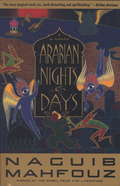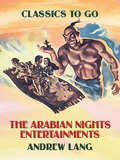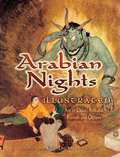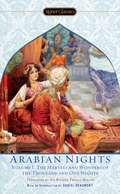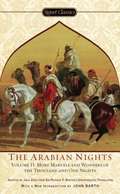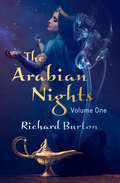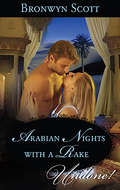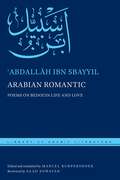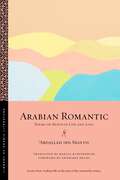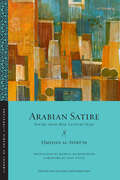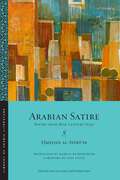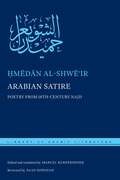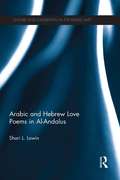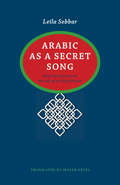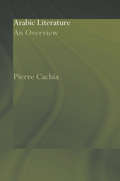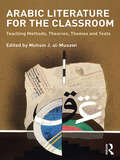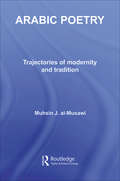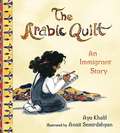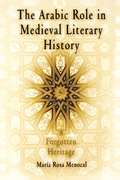- Table View
- List View
Arabian Nights and Days
by Naguib MahfouzA renowned Nobel Prize-winning novelist refashions the classic tales of Scheherazade in his own imaginative, spellbinding style. Here are genies and flying carpets, Aladdin and Sinbad, Ali Baba, and many other familiar stories, made new by the magical pen of the acknowledged dean of Arabic letters.
The Arabian Nights Entertainments: Large Print (Classics To Go)
by Andrew LangA collection of 26 tales told by Scheherazade to save herself and other young girls from death at the Sultan's hands. The story of the merchant and the genius -- The story of the first old man and of the hind -- The story of the second old man and of the two black dogs -- The story of the fisherman -- The story of the Greek king and the physician Douban -- The story of the husband and the parrot -- The story of the vizir who was punished -- The story of the young king of the black isles -- The story of the three Calenders [Calendars], sons of kings, and of five ladies of Baghdad -- The story of the first Calender [Calandar], son of a king -- The story of the second Calender [Calandar], son of a king -- The story of the envious man, and of him who was envied -- The story of the third Calendar [Calandar], son of a king -- The seven voyages of Sindbad [Sinbad] the sailor. The little hunchback -- The story of the barber's fifth brother -- The story of the barber's sixth brother -- The adventures of Prince Camaralzaman and the Princess Badoura -- Noureddin and the fair Persian -- Aladdin and the wonderful lamp -- The adventures of Haroun-al-Raschid, caliph of Baghdad -- Story of the blind Baba-Abdalla -- The story of Sidi-Noumann -- Story of Ali Cogia, merchant of Baghdad -- The enchanted horse -- The story of two sisters who were jealous of their younger sister. (Goodreads)
Arabian Nights Illustrated: Art of Dulac, Folkard, Parrish and Others
by Jeff A. MengesAccording to legend, a resourceful bride won a stay of execution by captivating a sultan with a series of fantastic tales--and after 1,001 nights, the sultan could not bear to part with his storyteller. More than a thousand years later, readers continue to fall under the spell of the romantic adventures known as the Arabian Nights. This original collection features rare and unusual illustrations inspired by the traditional tales of Sinbad, Aladdin, Ali Baba, and a host of other exotic characters.Spanning the decades between the 1890s and the 1920s, this volume draws upon images from the Golden Age of Illustration, when technological advances in printing led to a boom in the publication of artwork. Drawings and paintings by Maxfield Parrish, Edmund Dulac, Charles Folkard, and other acclaimed artists of the era appear here, in more than 185 color and black-and-white illustrations with captions. Abounding in mystery and excitement, these scenes from the timeless tales of heroism will captivate all lovers of fantasy and fairy tales, as well as collectors of rare books and art and illustration enthusiasts.
Arabian Nights Kathalu
by C.V.S. RajuArabian Nights is a set of 15 Telugu stories picked from the famous Arabian Night stories which is a set of Middle Eastern and South Asian folk stories.
The Arabian Nights, Volume I
by Jack Zipes Daniel Beaumont Anonymus Sir Richard Francis BurtonEnjoy the timeless tales of Aladdin, Sinbad, Ali Baba and the Forty Thieves, and many more in this first volume of The Arabian Nights. Upon learning of his queen's infidelity, proud King Shahryar has her killed. As revenge on womankind, he decides to wed a different virgin every night, only to have her beheaded at dawn. Such is Shahryar's practice for three terrible years--until he weds Scheherazade, the maiden who will change his life....A breathtaking beauty, Scheherazade is as learned as she is sensuous. Her first night with the king, she uses her imagination, her eloquence, and more than a little cunning to regale him with a tale of genies and wishes, wisely cutting the story short at dawn. The king is so beguiled, he cannot have her murdered without hearing the story's end. From then on, Scheherazade spends nights conjuring stories of flying carpets and fantastical journeys, always stopping with a cliff-hanger--and saving her own life.This edition follows the unexpurgated translation of Richard F. Burton, the renowned Victorian explorer. Intricate and inventive, these stories within stories continue to captivate readers as they have for centuries.
The Arabian Nights, Volume II
by AnonymousThis collection of over 40 tales, including Aladdin and his Magic Lamp, Ali Baba and the Forty Thieves and the Sinbad stories, is adapted directly from the unexpurgated 1886 10-volume translation by Sir Richard F. Burton.
The Arabian Nights, Volume II
by Jack Zipes AnonymousVolume two in a collection of tales representing distinctive genres- from fairy tales to erotica-revealing the customs and societies in the medieval Middle East, as told by the mythic Sheherazade.
The Arabian Nights Volume One: More Marvels And Wonders Of The Thousand And One Nights (The Arabian Nights #1)
by Richard BurtonThe first volume of the classic collection of Middle Eastern stories, including &“Tale of the Three Apples&” and &“Tale of the Trader and the Jinni.&” To be chosen by King Shahriyar as a wife was a death sentence. After a single night of marriage, he executed each of his wives. So when Scheherazade was picked, she knew her time on Earth had reached its end—unless she could hold the king&’s interest. To that end, each night she spun a new enchanting, erotic, mesmerizing tale, always keeping the king guessing as to its conclusion—and sparing her life for another thousand and one nights. The first volume of this collection, translated by the renowned British explorer Sir Richard Burton, begins the stories that Scheherazade told . . .
Arabian Nights with a Rake
by Bronwyn ScottAlgerian Desert, 1833Held captive in a Bedouin camp, Susannah Sutcliffe was bid to dress in scandalous silks and dance for the sheikh's guests. The request wasn't new to Susannah--but the presence of English diplomat Alex Grayfield was a shock she had not anticipated! Handsome and charming, Alex exuded a powerful masculinity that Susannah found irresistible...and he was unmistakably aroused by her sensual dance. Soon, Susannah had a plan to escape her desert captors: convince Alex to rescue her--by seducing him....
Arabian Romantic: Poems on Bedouin Life and Love (Library of Arabic Literature #33)
by ʿAbdallāh ibn SbayyilLove poems from late nineteenth-century Arabia Arabian Romantic captures what it was like to live in central Arabia before the imposition of austere norms by the Wahhabi authorities in the early twentieth century: tales of robbery and hot pursuit; perilous desert crossings; scenes of exhaustion and chaos when water is raised from deep wells under harsh conditions; the distress of wounded and worn-out animals on the brink of perdition; once proud warriors who are at the mercy of their enemy on the field of battle. Such images lend poignancy to the suffering of the poet’s love-stricken heart, while also painting a vivid portrait of typical Bedouin life. Ibn Sbayyil (ca. 1853–1933), a town dweller from the Najd region of the Arabian Peninsula, was a key figure in the Nabati poetic tradition. His poetry, which is still recited today, broke with the artifice of the preceding generation by combining inherited idiom and original touches reflecting his environment. Translated into English for the first time by Marcel Kurpershoek, Arabian Romantic will delight readers with a poetry that is direct, fluent, and expressive, and that has entertained Arabic speakers for over a century.A bilingual Arabic-English edition.
Arabian Romantic: Poems on Bedouin Life and Love (Library of Arabic Literature #69)
by ʿAbdallāh ibn SbayyilScenes from Arabian life at the turn of the twentieth centuryArabian Romantic captures what it was like to live in central Arabia before the imposition of austere norms by the Wahhabi authorities in the early twentieth century: tales of robbery and hot pursuit; perilous desert crossings; scenes of exhaustion and chaos when water is raised from deep wells under harsh conditions; the distress of wounded and worn-out animals on the brink of perdition; once proud warriors who are at the mercy of their enemy on the field of battle. Such images lend poignancy to the suffering of the poet’s love-stricken heart, while also painting a vivid portrait of typical Bedouin life.Ibn Sbayyil, a town dweller from the Najd region of the Arabian Peninsula, was a key figure in the Nabaṭī poetic tradition. His poetry, which is still recited today, broke with the artifice of the preceding generation by combining inherited idiom and original touches reflecting his environment. Translated into English for the first time by Marcel Kurpershoek, Arabian Romantic will delight readers with a poetry that is direct, fluent, and expressive, and that has entertained Arabic speakers for over a century.An English-only edition.
Arabian Satire: Poetry from 18th-Century Najd (Library of Arabic Literature #62)
by Ḥmēdān Al-ShwēʿirSatirical verse on society and its hypocrisiesA master of satire known for his ribald humor, self-deprecation, and invective verse (hijāʾ), the poet Ḥmēdān al-Shwēʿir was an acerbic critic of his society and its morals. Living in the Najd region of the Arabian Peninsula, Ḥmēdān wrote in an idiom widely referred to as “Nabaṭī,” here a mix of Najdī vernacular and archaic vocabulary and images dating to the origins of Arabic poetry. In Arabian Satire, Ḥmēdān is mostly concerned with worldly matters and addresses these in different guises: as the patriarch at the helm of the family boat and its unruly crew; as a picaresque anti-hero who revels in taking potshots at the established order, its hypocrisy, and its failings; as a peasant who labors over his palm trees, often to no avail and with no guarantee of success; and as a poet recording in verse how he thinks things ought to be.The poems in Arabian Satire reveal a plucky, headstrong, yet intensely socially committed figure—representative of the traditional Najdī ethos—who infuses his verse with proverbs, maxims, and words of wisdom expressed plainly and conversationally. Ḥmēdān is widely quoted by historians of the Gulf region and in anthologies of popular sayings. This is the first full translation of this remarkable poet.An English-only edition.
Arabian Satire: Poetry from 18th-Century Najd (Library of Arabic Literature #62)
by Ḥmēdān al-ShwēʿirSatirical verse on society and its hypocrisiesA master of satire known for his ribald humor, self-deprecation, and invective verse (hijāʾ), the poet Ḥmēdān al-Shwēʿir was an acerbic critic of his society and its morals. Living in the Najd region of the Arabian Peninsula, Ḥmēdān wrote in an idiom widely referred to as “Nabaṭī,” here a mix of Najdī vernacular and archaic vocabulary and images dating to the origins of Arabic poetry. In Arabian Satire, Ḥmēdān is mostly concerned with worldly matters and addresses these in different guises: as the patriarch at the helm of the family boat and its unruly crew; as a picaresque anti-hero who revels in taking potshots at the established order, its hypocrisy, and its failings; as a peasant who labors over his palm trees, often to no avail and with no guarantee of success; and as a poet recording in verse how he thinks things ought to be.The poems in Arabian Satire reveal a plucky, headstrong, yet intensely socially committed figure—representative of the traditional Najdī ethos—who infuses his verse with proverbs, maxims, and words of wisdom expressed plainly and conversationally. Ḥmēdān is widely quoted by historians of the Gulf region and in anthologies of popular sayings. This is the first full translation of this remarkable poet.An English-only edition.
Arabian Satire: Poetry from 18th-Century Najd (Library of Arabic Literature #49)
by Ḥmēdān al-ShwēʿirThis lively volume collects poems by Hmedan al-Shwe'ir, who lived in Najd in the Arabian Peninsula shortly before the hegemony of the Wahhabi movement in the early eighteenth century.A master of satire known for his ribald humor, self-deprecation, and invective verse (hija'), Hmedan was acerbic in his criticisms of society and its morals, voiced in in a poetic idiom that is widely referred to as “Nabati,” here a mix of Najdi vernacular and archaic vocabulary and images dating back to the origins of Arabic poetry. In Arabian Satire, Hmedan is mostly concerned with worldly matters, and addresses these in different guises: as the patriarch at the helm of the family boat and its unruly crew; as a picaresque anti-hero who revels in taking potshots at the established order, its hypocrisy, and its moral failings; as a peasant who labors over his palm trees, often to no avail and with no guarantee of success; and as a poet recording in verse how he thinks things ought to be.The poems in Arabian Satire reveal a plucky, headstrong, yet intensely socially committed figure—representative of the traditional Najdi ethos—who infuses his verse with proverbs, maxims, and words of wisdom expressed plainly and conversationally. Hmedan is accordingly quoted by historians of the Gulf region and in anthologies of popular sayings. This is the first full translation of this remarkable poet. A bilingual Arabic-English edition.
Arabic and Hebrew Love Poems in Al-Andalus (Culture and Civilization in the Middle East)
by Shari LowinArabic and Hebrew Love Poems in al-Andalus investigates a largely overlooked subset of Muslim and Jewish love poetry in medieval Spain: hetero- and homo-erotic love poems written by Muslim and Jewish religious scholars, in which the lover and his sensual experience of the beloved are compared to scriptural characters and storylines. This book examines the ways in which the scriptural referents fit in with, or differ from, the traditional Andalusian poetic conventions. The study then proceeds to compare the scriptural stories and characters as presented in the poems with their scriptural and exegetical sources. This new intertextual analysis reveals that the Jewish and Muslim scholar-poets utilized their sacred literature in their poems of desire as more than poetic ornamentation; in employing Qur’ānic heroes in their secular verses, the Muslim poets presented a justification of profane love and sanctification of erotic human passions. In the Hebrew lust poems, which utilize biblical heroes, we can detect subtle, subversive, and surprisingly placed interpretations of biblical accounts. Moving beyond the concern with literary history to challenge the traditional boundaries between secular and religious poetry, this book provides a new, multidisciplinary, approach to existing materials and will be of interest to students, scholars and researchers of Islamic and Jewish Studies as well as to those with an interest in Hebrew and Arabic poetry of Islamic Spain.
Arabic As A Secret Song (CARAF Books: Caribbean and African Literature Translated from French)
by Skyler ArtesThe celebrated and highly versatile writer Leïla Sebbar was born in French colonial Algeria but has lived nearly her entire adult life in France, where she is recognized as a major voice on the penetrating effects of colonialism in contemporary society. The dramatic contrast between her past and present is the subject of the nine autobiographical essays collected in this volume. Written between 1978 and 2006, they trace a journey that began in Aflou, Algeria, where her father ran a schoolhouse, and continued to France, where Sebbar traveled, alone, as a graduate student before eventually realizing her powerful creative vision. The pieces collected in this book capture an array of experiences, sensations, and sentiments surrounding the French colonial presence in Algeria and offer an intimate and prismatic reflection on Sebbar’s bicultural upbringing as the child of an Algerian father and French mother. Sebbar paints an unflinching portrait of her original disconnection from her father’s Arabic language and culture, depicting her struggle to revive a cultural heritage that her family had deliberately obscured and to convey the vibrant yet muted Arabic of her father and of Algeria. Looking back from numerous vantage points throughout her life, she presents the complicated and divisive dynamics of being raised "between two shores"--the colonized and the colonizer. CARAF Books: Caribbean and African Literature Translated from French
Arabic Literature: An Overview (Culture and Civilization in the Middle East)
by Pierre CachiaAssuming no previous knowledge of the subject, Arabic Literature - An Overview gives a rounded and balanced view of Arab literary creativity. 'High' literature is examined alongside popular folk literature, and the classical and modern periods, usually treated separately, are presented together. Cachia's observations are not subordinated to any pre-formed literary theory, but describe and illustrate the directions taken, in order to present an overall picture of the field of relevance to the student of literature as well as to Arabists working in related fields.
Arabic Literature for the Classroom: Teaching Methods, Theories, Themes and Texts
by Mushin J al-MusawiArabic Literature for the Classroom argues for a more visible presence of Arabic within the humanities and social sciences, stressing the need to make Arabic literature available as a world literature, without damaging its own distinctive characteristics. The nineteen chapters which make up this book broach theoretical and methodical cultural concerns in teaching literatures from non-American cultures, along with issues of cross-cultural communication, cultural competency and translation. While some chapters bring out the fascinating and ever tantalizing connections between Arabic and the literatures of medieval Europe, others employ specific approaches to teaching particular texts, potential methodologies, themes and a variety of topics that can place Arabic widely in a vast swathe of academic application and learning. Topics that are explored include gender, race, class, trauma, exile, dislocation, love, rape, humor, and cinema, as well as issues that relate to writers and poets, women’s writing and the so called nahdah (revival) movement in the 19th Century. The comparative framework and multi-disciplinary approach means that this book injects new life into the field of Arabic Literature. It will therefore be an essential resource for students, scholars and teachers of Arabic Literature, as well as for anyone with an interest in learning more about Arabic culture.
Arabic Literature in the Post-Classical Period
by Roger Allen D. S. RichardsThe final volume of The Cambridge History of Arabic Literature explores the Arabic literary heritage of the little-known period from the twelfth to the beginning of the nineteenth century. Even though it was during this time that the famous Thousand and One Nights was composed, very little has been written on the literature of the period generally. In this volume Roger Allen and Donald Richards bring together some of the most distinguished scholars in the field to rectify the situation. The volume is divided into parts with the traditions of poetry and prose covered separately within both their 'elite' and 'popular' contexts. The last two sections are devoted to drama and the indigenous tradition of literary criticism. As the only work of its kind in English covering the post-classical period, this book promises to be a unique resource for students and scholars of Arabic literature for many years to come.
Arabic Literature to the end of the Umayyad Period
by A. F. L. Beeston T. M. Johnstone R. B. Serjeant G. R. SmithOriginally published in 1983, The Cambridge History of Arabic Literature was the first general survey of the field to have been published in English for over fifty years and the first attempted in such detail in a multi-volume form. The volumes of the History provide an invaluable source of reference and understanding of the intellectual, literary and religious heritage of the Arabic-speaking and Islamic world. This volume begins its coverage with the oral verse of the sixth century AD, and ends with the fall of the Umayyad dynasty two centuries later. Within this period fall major events: the life of the Prophet Muhammad, the founding of the Islamic religion, the great Arab Islamic conquests of territories outside the Arabian Peninsula, and their meeting, as overlords, with the Byzantine and Sasanian world. Contributors to this volume discuss an array of topics including the influences of Greeks, Persians and Syrians on early Arabic literature.
Arabic Poetry: Trajectories of Modernity and Tradition (Routledge Studies in Middle Eastern Literatures)
by Muhsin J. al-MusawiSince the late 1940s, Arabic poetry has spoken for an Arab conscience, as much as it has debated positions and ideologies, nationally and worldwide. This book tackles issues of modernity and tradition in Arabic poetry as manifested in poetic texts and criticism by poets as participants in transformation and change. It studies the poetic in its complexity, relating to issues of selfhood, individuality, community, religion, ideology, nation, class and gender. Al-Musawi also explores in context issues that have been cursorily noticed or neglected, like Shi’i poetics, Sufism, women’s poetry, and expressions of exilic consciousness. Arabic Poetry employs current literary theory and provides comprehensive coverage of modern and post-modern poetry from the 1950s onwards, making it essential reading for those with interests in Arabic culture and literature and Middle East studies.
The Arabic Print Revolution
by Ami AyalonIn a brief historic moment, printing presses, publishing ventures, a periodical press, circulation networks, and a mass readership came into being all at once in the Middle East, where none had previously existed, with ramifications in every sphere of the community's life. Among other outcomes, this significant change facilitated the cultural and literary movement known as the Arab 'nahda' ('awakening'). Ayalon's book offers both students and scholars a critical inquiry into the formative phase of that shift in Arab societies. This comprehensive analysis explores the advent of printing and publishing; the formation of mass readership; and the creation of distribution channels, the vital and often overlooked nexus linking the former two processes. It considers questions of cultural and religious tradition, social norms and relations, and concepts of education, offering a unique presentation of the emerging print culture in the Middle East.
The Arabic Quilt: An Immigrant Story
by Aya KhalilKanzi’s family has moved from Egypt to America, and on her first day in a new school, what she wants more than anything is to fit in. Maybe that’s why she forgets to take the kofta sandwich her mother has made for her lunch, but that backfires when Mama shows up at school with the sandwich. Mama wears a hijab and calls her daughter Habibti (dear one). When she leaves, the teasing starts. <P><P> That night, Kanzi wraps herself in the beautiful Arabic quilt her teita (grandma) in Cairo gave her and writes a poem in Arabic about the quilt. Next day her teacher sees the poem and gets the entire class excited about creating a “quilt” (a paper collage) of student names in Arabic. In the end, Kanzi’s most treasured reminder of her old home provides a pathway for acceptance in her new one. <P><P> This authentic story with beautiful illustrations includes a glossary of Arabic words and a presentation of Arabic letters with their phonetic English equivalents. <P><P><i>Advisory: Bookshare has learned that this book offers only partial accessibility. We have kept it in the collection because it is useful for some of our members. Benetech is actively working on projects to improve accessibility issues such as these.</i>
The Arabic Role in Medieval Literary History
by Maria Rosa MenocalArabic culture was a central and shaping phenomenon in medieval Europe, yet its influence on medieval literature has been ignored or marginalized for the last two centuries. In this ground-breaking book, now returned to print with a new afterword by the author, María Rosa Menocal argues that major modifications of the medieval canon and its literary history are necessary.Menocal reviews the Arabic cultural presence in a variety of key settings, including the courts of William of Aquitaine and Frederick II, the universities in London, Paris, and Bologna, and Cluny under Peter the Venerable, and she examines how our perception of specific texts including the courtly love lyric and the works of Dante and Boccaccio would be altered by an acknowledgment of the Arabic cultural component.
